I don’t know about you, but when I think of a tropical paradise, I think of lush rainforests with broad leaves, exotic foliage, and rich greens – with dashes of vibrant colors.
And a margarita in hand…
Cocktails aside, to achieve that tropical vibe in your terrarium, you’re going to need the right mix of tropical terrarium plants. A certain variety that can pull together all the important elements of thick foliage, wild growth, and contrast.
Playing with scale and texture is the key to pulling this off (as we’re not about to fit a palm tree in a terrarium), but we have some tricks up our sleeves…
So, without any further adieu, here’s a selection of terrarium plants that’ll give you that perfect tropical paradise.

Terrarium Tribe is reader-supported. When you purchase through links on our site, we may earn an affiliate commission (at no further cost to you). 💜
True Tropical Terrarium Plants
1. Ficus pumila (Creeping Fig)
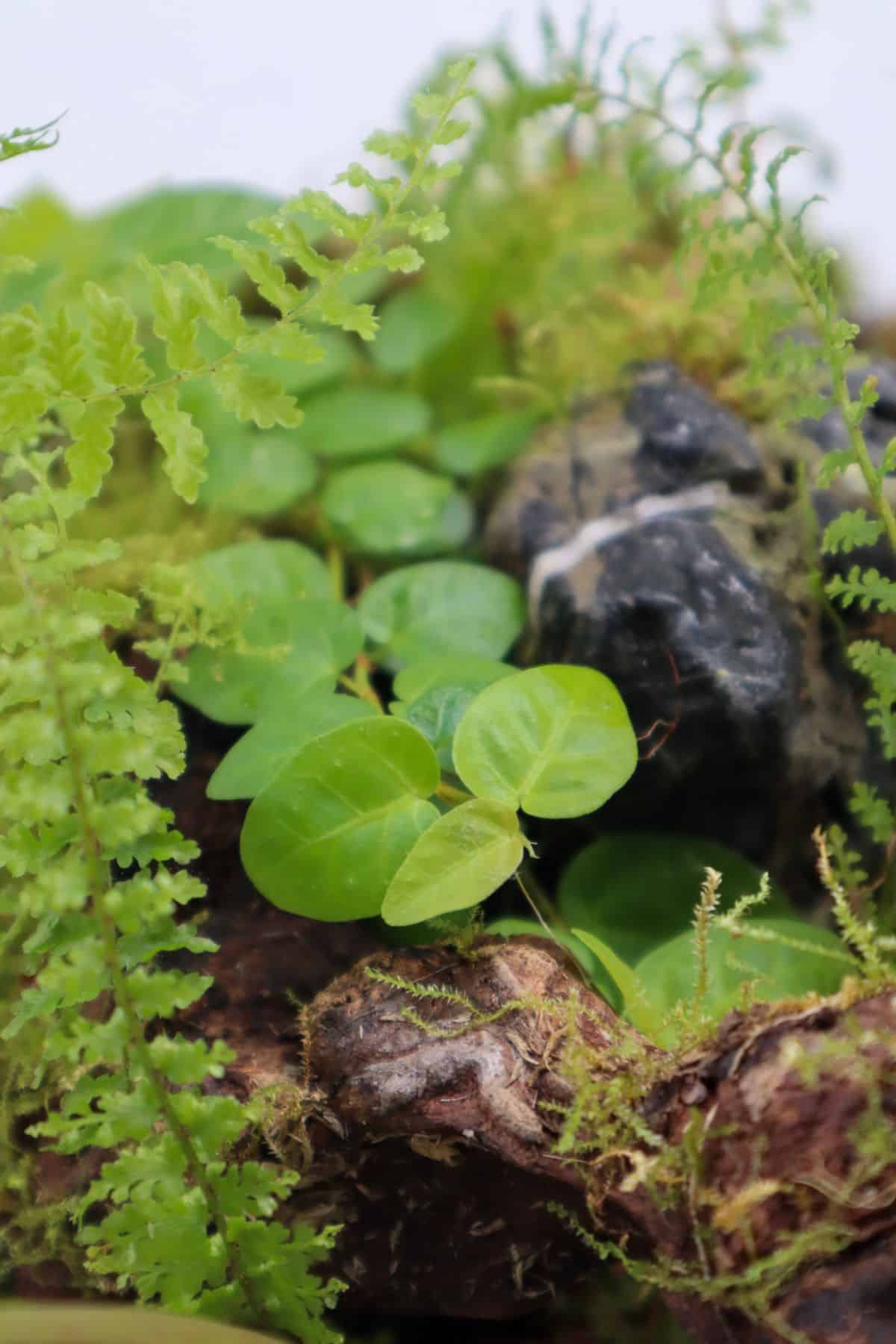
Native to the jungles of East Asia, this little trailing plant makes for fantastic ground cover.
Ficus pumila can quickly form a network of vines – in a completely unrestrained growth pattern – that’ll give a naturalistic feel to the base of a terrarium. The ‘Minima’ variety is extra petite if you’re working with a small container.
A true terrarium classic, the Creeping Fig comes in several varieties that can really help pull together your tropical scene.
2. Macodes petola (Lightning Jewel Orchid)

When it comes to exotic-looking plants, it’s hard to overlook the so-called “Lightning Jewel Orchid.”
Macodes petola is a stunning tropical jewel orchid with a signature electric gold pattern that pierces the full length of the foliage.
Native to a variety of Southeast Asian jungle areas, this bold plant should take center stage in the foreground of a tropical terrarium where it can be fully appreciated.
👉 Shop Macodes petola on Etsy.
3. Microsorum musifolium (Crocodile Fern)

Another super unique-looking fern; it’s not hard to see where the crocodile fern gets its name…
With its characteristic scaly green leaves, the foliage of Microsorum musifolium looks like they’re taken straight from a crocodile’s back.
Definitely, one for larger terrariums, as just like those saltwater crocs they can grow pretty large!
👉 Shop the Crocodile Fern on Etsy.
4. Neoregelia

For a true splash of tropical color amongst the lush greens, there’s no better plant than a fiery red Neoregelia ‘Fireball,’ or there’s a ‘Green Fireball’ variety, too (if you’re looking to keep the green look throughout).
Growing in compact but bright rosettes, these epiphytic Bromeliads come in an enormous variety of colors and cultivars.
👉 Shop Neoregelia ‘Fireball’ on Etsy.
5. Biophytum sensitivum
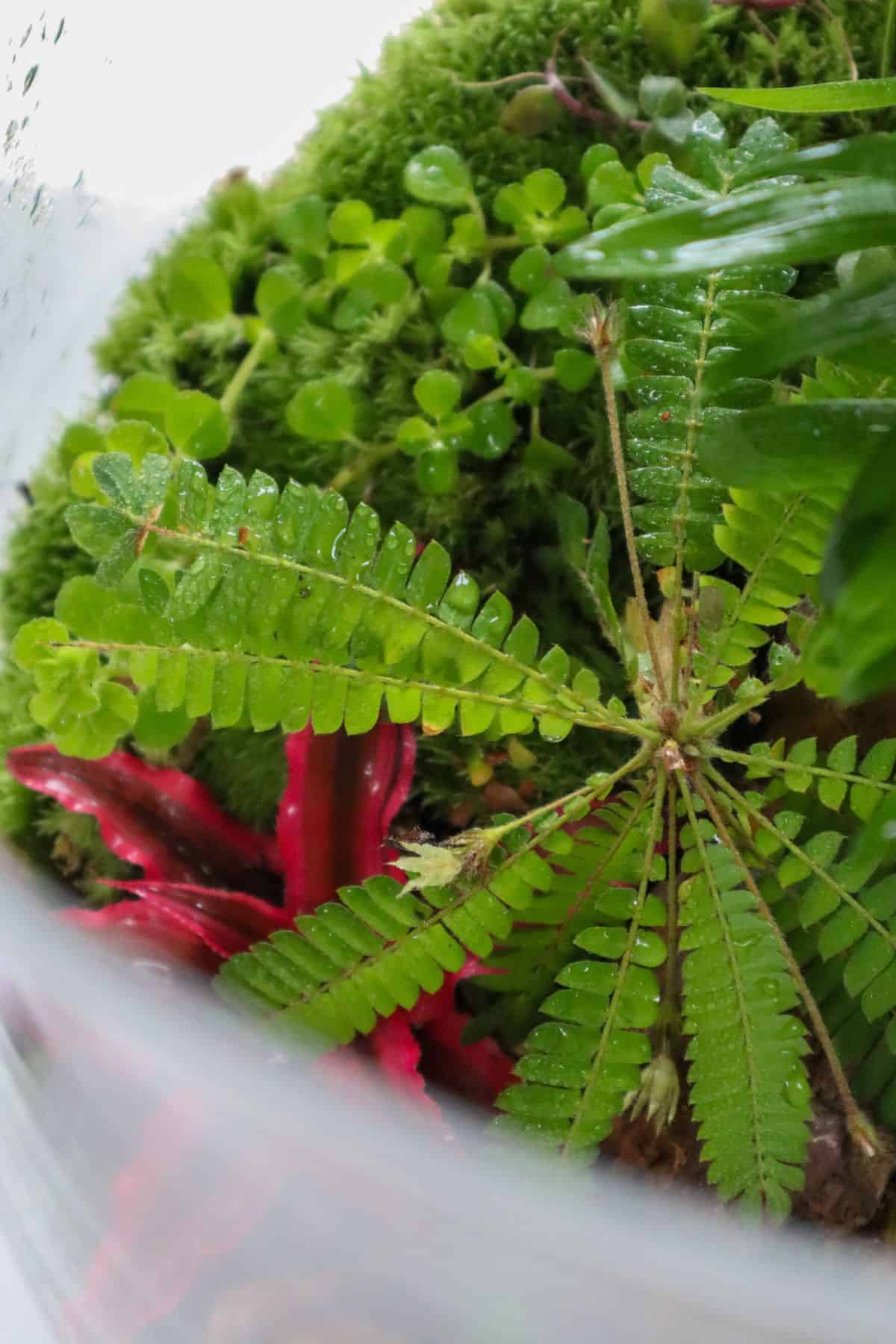
Nothing says tropical like a palm tree, but as we’ve said, we can’t fit one of those in a terrarium… or can we?
Well, Biophytum sensitivum (otherwise known as the “Little Tree Plant”) is the next best thing.
Native to wetland areas of India and Nepal, this miniature palm-like plant is a true tropical beauty. With delicate branches of leaves radiating outward from a central crown, they gently fold up when touched and at night.
Combining this plant with tropical moss provides a fantastic illusion of a miniature tropical scene.
👉 Shop Biophytum sensitivum on Etsy.
6. Humata heterophylla

A lesser-known fern masquerading as a vine, Humata heterophylla is a gorgeous emerald-green plant with a unique ridged texture.
Another native epiphyte that’s found growing on rainforest trunks in the wild, this versatile plant can be planted in the substrate or mounted on your terrarium hardscape. As long as it can get plenty of moisture, it’ll thrive in a closed terrarium environment.
However you apply it in a terrarium, its wonderful vining nature makes for an element of wild growth that can add some great natural flair.
7. Asplenium nidus ‘Crispy Wave’

Native to the jungles of Southeast Asia, the Bird’s Nest Fern is one of the few ferns with broad, tropical-looking leaves.
With a characteristic ruffled leaf shape and circular growth pattern, it really adds an exotic element to a terrarium.
In its natural environment, it’s often found growing epiphytically in the crooks of large trees, but it’ll do best planted in the background of a tropical terrarium where it’ll have space to grow out.
👉 Shop Asplenium nidus ‘Crispy Wave’ on Etsy.
8. Syngonium podophyllum ‘Pixie’
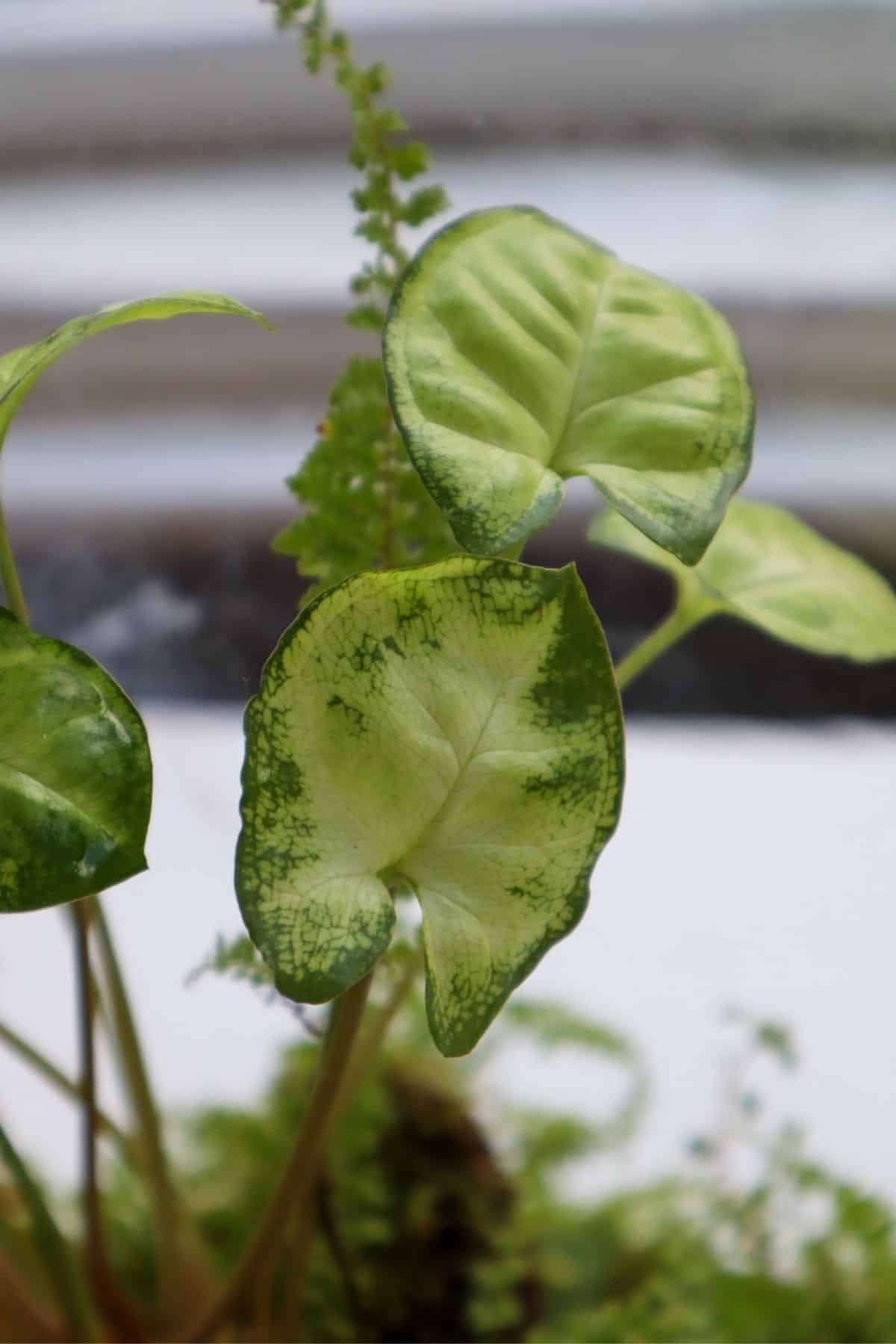
The Arrowhead Vine is a true tropical rainforest staple. Native to a wide variety of areas in South America, this versatile species is often found weaving its way through the rainforest canopy.
In a humid closed terrarium environment, Syngonium podophyllum will grow without restraint. So, picking up the dwarf ‘Pixie‘ variety is a good choice to make sure it stays compact.
👉 Shop Syngonium podophyllum ‘Pixie’ on Etsy.
9. Anubias barteri var. nana ‘Petite’
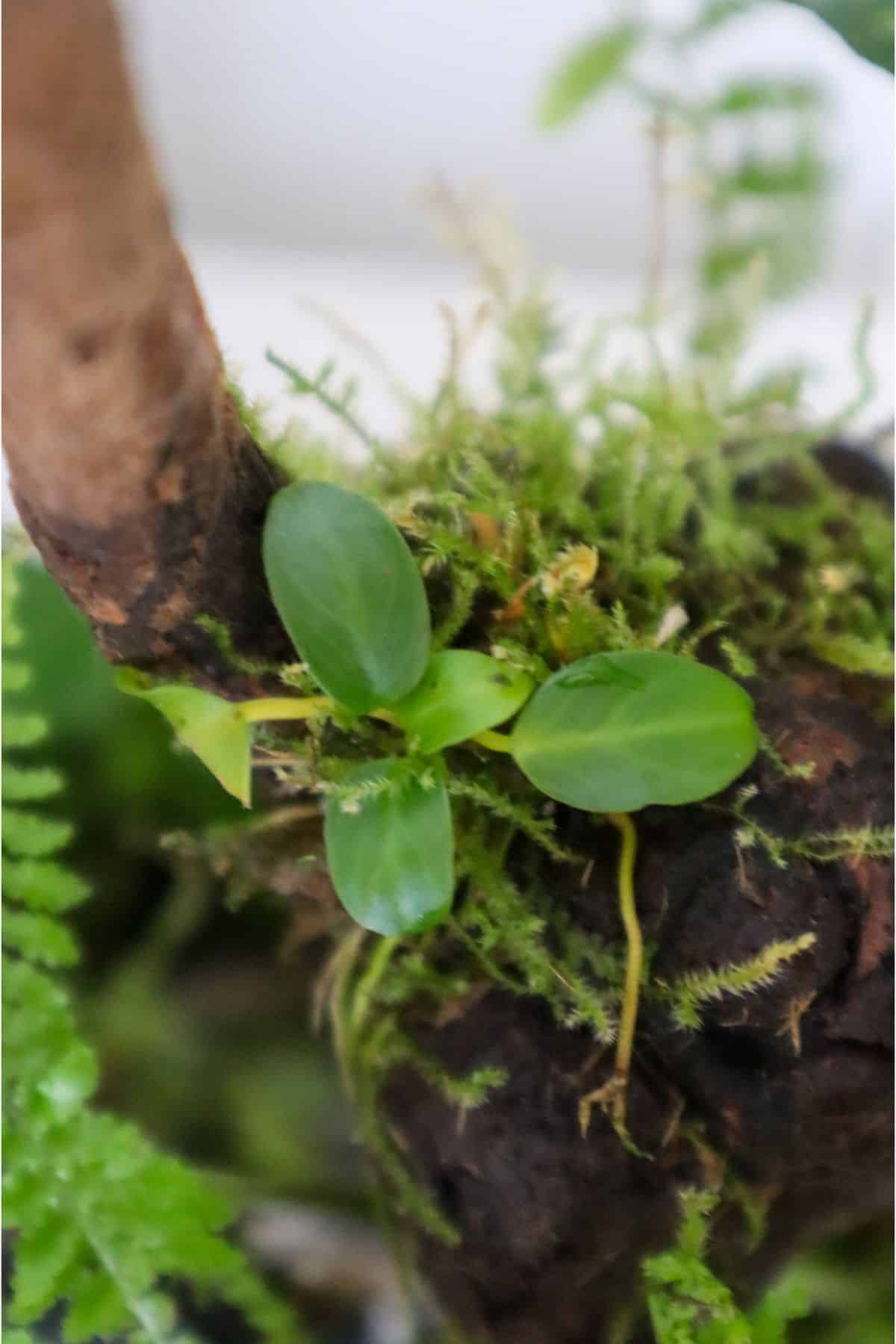
Normally an aquatic species, Anubias barteri var. nana ‘Petite’ has found a home in the terrarium trade as a tropical-looking epiphyte.
With its flat leaves and dark green foliage, it adds some wonderful contrast to a terrarium.
Naturally, as an aquatic plant, it requires a lot of humidity and constant moisture to survive in the open air, but that’s exactly the kind of conditions in a tropical terrarium.
The ‘Petite’ variety is one of the smallest varieties, but you can also try the Anubias nana ‘Mini,’ ‘Coin,’ and ‘Bonsai’ for other small options.
👉 Shop Anubias barteri var. nana ‘Petite’ on Etsy.
10. Tillandsia

One of the easier Air Plants to grow in terrariums, Tillandsia are a truly exotic species.
I particularly like Tillandsia bulbosa for its long, tentacle-like growth. It can really fill the space in the canopy and make for some exciting 3D features. Plus, you can place them anywhere you can balance them (they don’t attach), so it opens up new planting opportunities.
As with all air plants, they tend to prefer a little bit of airflow, but this species is the most forgiving.
👉 Shop Tillandsia bulbosa on Etsy.
11. Terrarium Moss!
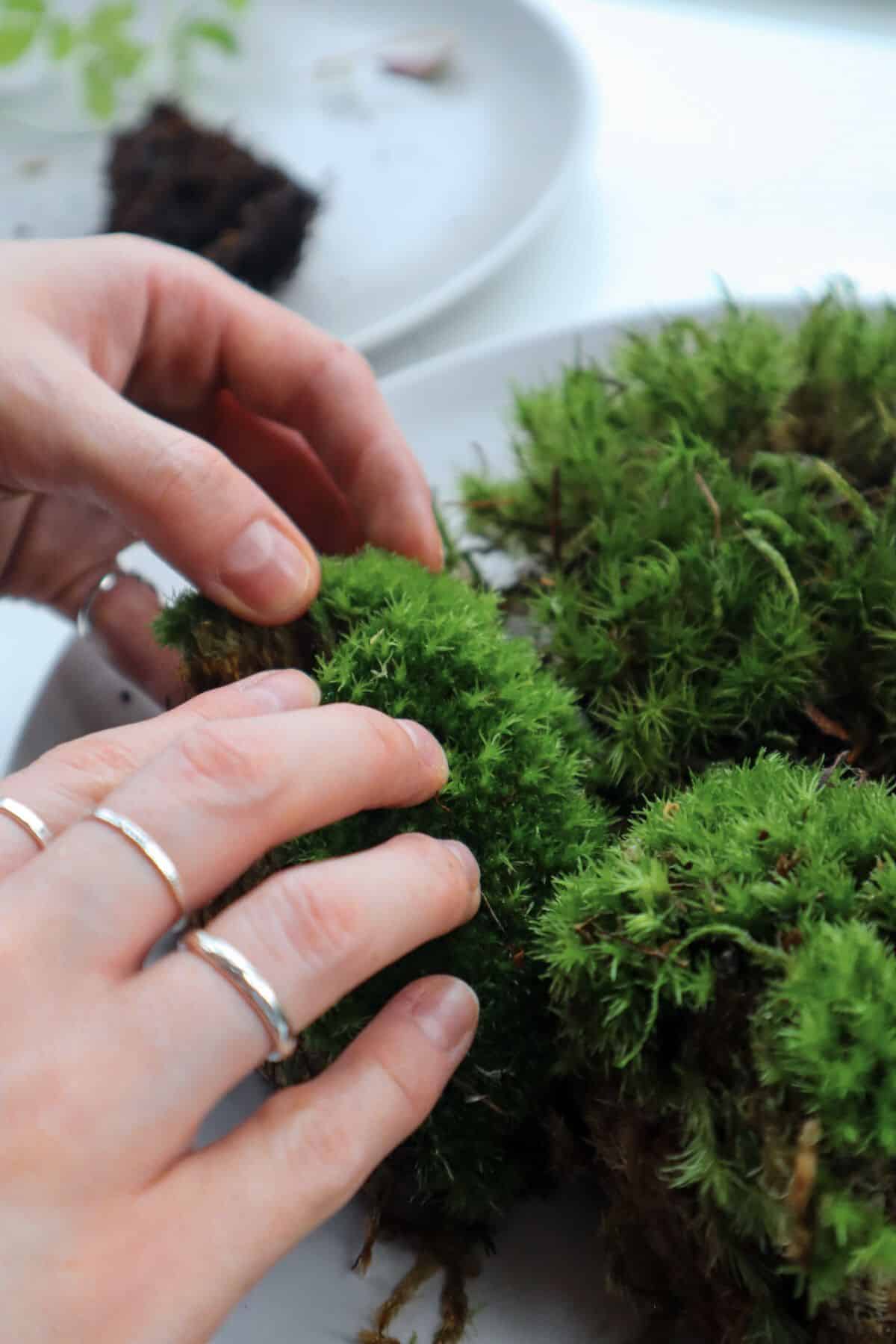
Okay, no natural rainforest scene would be complete without tropical moss. It’s the understated hero that pulls together the final look.
When playing with scale, a vibrant moss like this can be used to look like windswept plains or a lush tropical floor.
Many tropical mosses would work well in our slice of paradise, but Cushion Moss and Mood Moss are particularly good choices for their vibrant green colors and lush foliage.
👉 You can find both on our store! See our collection of live terrarium moss for sale.
Wrapping Up
In reality, most terrarium plants are tropical in nature. It goes hand-in-hand with the high humidity, warmth, and moisture of a closed terrarium environment.
So whilst this is my list of particularly tropical-looking plants, there’s actually a wide variety of options out there to explore.
If you need any more help, be sure to check out our definitive guide to sealed terrarium plants or our picks of the best terrarium plants.
What’s your favorite tropical terrarium plant on this list?
Let us know in the comments below!
And if you already have your tropical plants picked out, why not check out our online terrarium store for the rest of your supplies?

Great list Dan. I have several of the plants listed in my terrariums and paludariums. I especially like Ficus pumila. It also makes a great aquatic or marginal plant. It looks awesome growing up out of the water up a waterfall! I also have Syngonium podophyllum “pixie” in several terrariums that I converted from used aquariums. Anubias barteri var. nana ‘Petite’ is growing in my paludariums along with Neoregelia ‘Fireball and various mosses I’ve collected from my yard. I think Hypnum cupressiforme is in the mix. Mosses really complete a terrarium I think. I’m glad to be a member of the Terrarium Tribe!
Jim
Thanks Jim, great minds think alike! Sounds like you have quite the tropical setup 🙂
Very informative! A lot of useful information. Some of the plants are very difficult to acquire as well as grow. Getting live moss is especially difficult.
Hi Dan!
Is additional lighting needed if the terrarium is too far into the corner of the room, so there is not much light? how much extra light would not bother the snail and can be useful for the plants? Is such a combination possible at all?
Tank you!
Dusan
Hi Dusan, yeah if your terrarium is in a dark corner of the room it’s probably going to need some additional lighting. The ideal “bright, indirect light” still tends to only be a few feet away from a light source. Not sure on the snail I’m afraid, I avoid them because they eat plants!
Hello Dan, thank you so much for writing this page, I love terrariums so I wanted to make one, and I wanted it to remind me the tropics as much as possible because I love them. But I couldn’t find any examples of tropical terrariums until I found this page, which is really useful and great. I even thought that no one wants to make terrariums that simulate tropical landscape, so I was really surprised when I found this webpage.